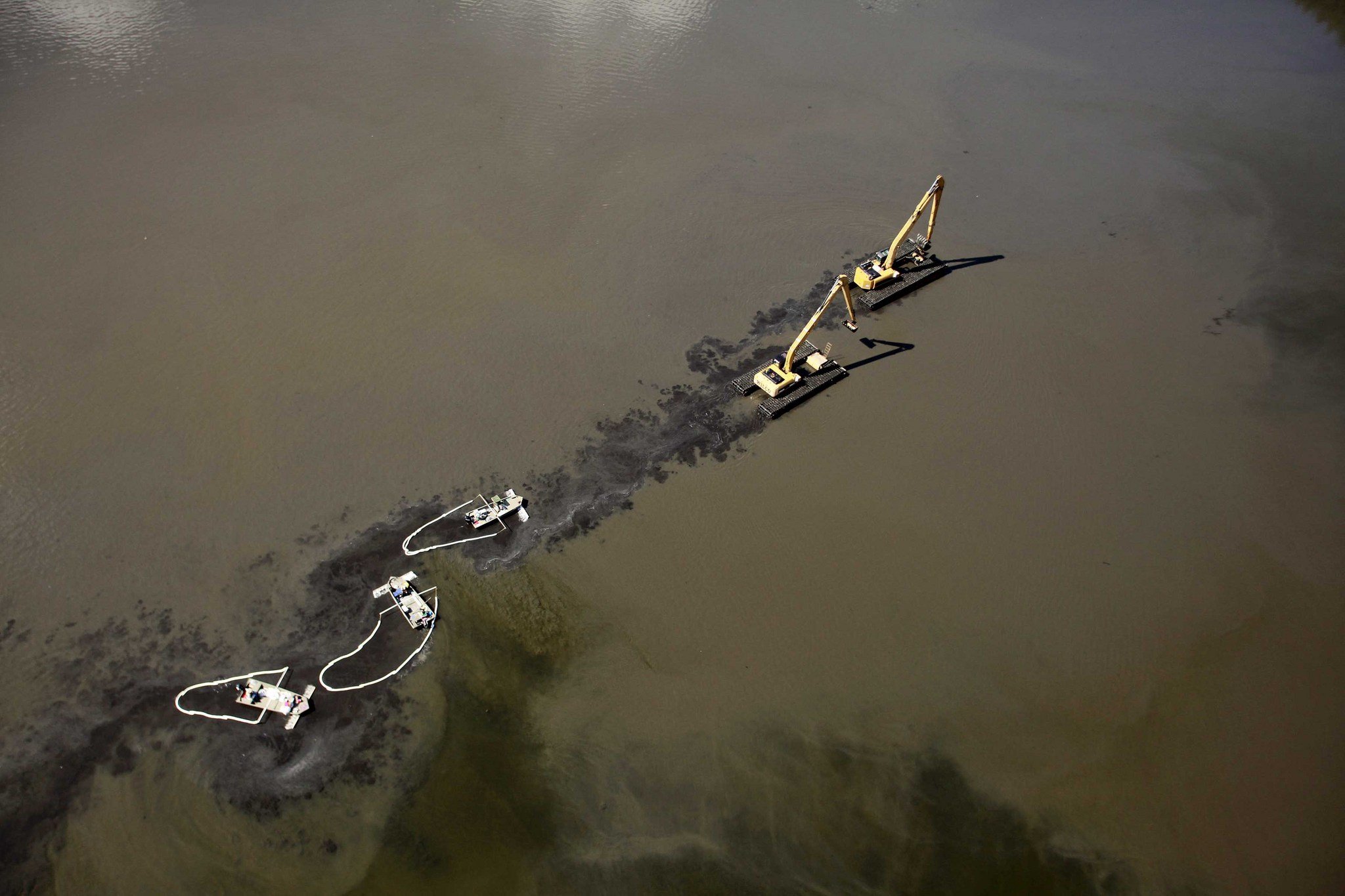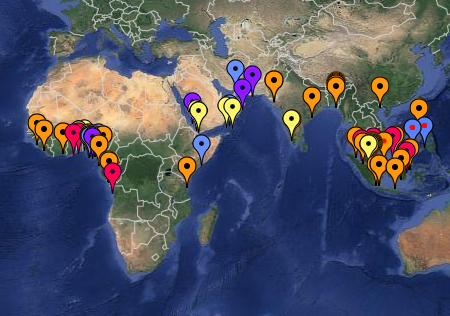airboats clean up oil spill
published: Sunday, 04 September 2011
by Fritz Klug
Cleanup shifts to Morrow Lake and delta (with aerial photos)
COMSTOCK TOWNSHIP — Thirty miles from where the oil pipeline ruptured, cleanup efforts are slow and steady.
Workers driving large cranes, each equipped with a bucket at the end of a 100-foot arm, stir up sediment, releasing oil trapped at the bottom of the lake. The sheen rises to the surface and is collected by containment booms, which are pulled by boats following the cranes. Back and forth, the cranes and boats slowly crisscross the water.
This cleanup isn’t occurring in Marshall, Battle Creek or anywhere else in Calhoun County. This site is in Comstock Township in Kalamazoo County, a 13-minute drive east of downtown Kalamazoo.
Fourteen months later

Aerial view of two excavators digging into Morrow Lake for submerged oil as three boats with absorbent booms follow to collect the oil Friday, August 26.
Fourteen months after an Enbridge Inc. pipeline ruptured in July 2010, leaking more than 800,000 gallons of oil into the Kalamazoo River, crews are focusing on extracting submerged oil from the Kalamazoo-Calhoun county line to Morrow Lake in Comstock.
This spring, the Environmental Protection Agency assessed the spill and identified three areas where nearly 200 acres of submerged oil had collected: the Ceresco Dam; in Mill Pond, just east of Battle Creek, and where the Kalamazoo River flows into Morrow Lake and the delta leading into the lake.
All three sites are natural collection points for sediment, with the largest — Morrow Lake and its delta — totaling 90 acres.
The EPA gave Enbridge until Aug. 31 to clean up the submerged oil, but the Alberta-based company failed to meet the deadline. Enbridge said several factors kept it from doing so, including finding oil in another 142 acres of river sediment.
Significant progress this summer
But Enbridge and the EPA say there has been significant cleanup progress this summer. In a letter the company sent to the EPA on Monday, Enbridge said it expected crews to finish cleaning up submerged oil up to the Fort Custer Recreation Area in Augusta by Aug. 31, with the exception of an area above Ceresco Dam.
By the first week in October, Enbridge said the cleanup of the nearly 200 acres should be finished, according to the letter. Another week may be needed to clean up any additional oil, it said.
In May and June, Enbridge, state and federal agencies assessed the 30-mile area of the Kalamazoo River and Talmadge Creek affected by the spill. They found 195 acres of submerged oil in 214 locations; Enbridge says it has cleaned 103 locations, according to the letter. Of the remainder, 65 locations are currently being cleaned up and 46 sites are waiting to be addressed.
But in coming weeks, officials said, it will take longer to get the submerged oil to shake free from the sediment because the removal process is less effective in cooler temperatures.
Past the dam
Among the greatest fears after the spill occurred was whether oil would be found past Morrow Dam and spread farther west down the Kalamazoo River.
Recent monitoring showed no oil has slipped past the dam, or even reached the western sections of Morrow Lake, said Ralph Dollhopf, the EPA’s incident commander for the spill.
The submerged oil is concentrated in both the delta leading into Morrow Lake and in the eastern part of the lake.
“That’s a long way from the dam,” he said.
Submerged oil
The heavy crude oil that spilled from Enbridge’s 6B pipeline was diluted bitumen, a mixture of heavy tar sands oil mixed with chemical compounds to make it flow easier through the pipeline.
When the oil started spilling into the Kalamazoo River, the lighter parts evaporated and the heavier parts sank to the bottom of the river, mixing with the sediment. Enbridge has approached the cleanup in a “bottom-down” approach, company spokesman Jason Manshum said, collecting the oil from the spill site in Marshall and moving downriver.
The method has worked, the EPA and Enbridge have said, as 766,000 gallons of oil so far have been collected, according to Aug. 11 data from the EPA. But even after this phase of the cleanup is completed, the EPA says it expects to find more submerged oil during future assessments, which will require cleanup by Enbridge.
There now are 36 boats, most of which are dragging containment booms, 130 workers and six cranes dedicated to the cleanup of Morrow Lake and the delta area, Manshum said. Along the entire affected area of the river, Enbridge says it has 600 workers, 211 boats and 78 pieces of machinery.
Lasting impact
Like other places along the Kalamazoo River affected by the spill, River Oaks Park has been closed to the public since July 2010. Public boat launches now are used to move airboats and cranes on and off the lake. It’s been a summer lost for recreation — from boating and swimming to fishing and hunting.
Kalamazoo County officials are monitoring the cleanup with state and federal agencies to determine when the affected areas of the river can be reopened to the public.
Kalamazoo County Sheriff Richard Fuller said his biggest concern is what will happen to the water system years from now.
“I want to make sure everything is done now to make sure 20 years from now we are not getting some sort of chemicals in the water systems that had never been there before,” Fuller said.
[youtube=http://youtu.be/hja1bwY7DCg&rel=0]

















